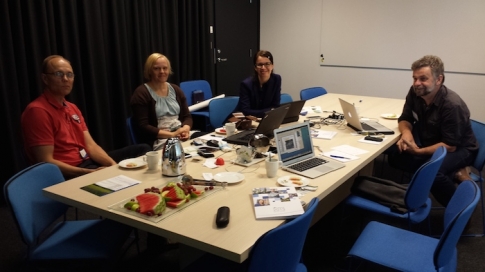News
2014-06-11
Meeting Fingrid in Helsinki
Almost during summer longest days, the LIFE ELIA team met Fingrid (the Finnish Transmission System Operator (TSO)) in Helsinki on June 11th and 12nd 2014.
Meeting in Fingrid headquarters
As usual in a TSO meeting, the LIFE ELIA team presented the project, the 7 actions and the perspectives of partnership between the project and the TSO.

Finnish government main guideline addressed to Fingrid is to develop the grid if possible along existing lines or linear infrastructures such as highways or railways.
Nevertheless, Fingrid is sometimes facing local opposition to some projects of line upgrading or creation. The challenge of reaching social acceptability is indeed a key objective in a TSO strategy. We studied together how the LIFE ELIA project principles could contribute to a better consideration by public opinion.
On a vegetation management ground, Fingrid is both clearing vegetation and doing selective cuttings to let small trees and bushes to grow up.
Dealing with water and ice
Finland is a big country, ranking 5th in terms of size at European level. Around 10 % of the territory is covered by water, you can indeed encounter around 180.000 lakes throughout the country. Therefore, Fingrid has to deal with this feature and has developed know-how related to crossing open water with high-tension lines.

Another specific aspect of Fingrid's management is the issue of ice on cables. During harsh winters, maintenance units patrol to control if ice weight on cables is not threatening electricity transmission. If needed, ice is removed either manually or by using helicopter.
June 12th was dedicated to field visits on 3 different sites to better understand Fingrid actions for environment along the high-tension grid.

Field visit 1 : vegetation management with sheep in Nokia
Nokia town is famous for its mobile phone industry. But it is also a place where the municipality takes strong actions for biodiversity. Fingrid was contacted by Nokia green areas municipality planner in order to develop a project under a high-tension line close to a residential zone. The idea was to value a 4 ha meadow that was colonised by bushes and trees (mainly willows, aspen and spruces). A partnership was set up between Fingrid, the Nokia municipality and Nokia church (easements owners), Vattenfall (distribution system operator), the local administration for Environment, ProAgria (farming association), an organic famer and even a local football club.
You can now see on site 30 sheeps grazing the 4 ha zone divided on 2 zones : on the banks of a lake and the other on an island. Sheeps belong to a famer but local football club received money from Fingrid to look after the sheep. Fixed fences were installed thanks to subsidies, and Juniperus are carefully maintained.
This is a good example of easement integration into social contexts. Neighbours are pleased with this new vegetation management and local schools are making visits with young children.

Field visit 2 : an educational area under the lines
Another type of partnership has been created with Fingrid, Tampere municipality and a local school : creating a educational area under a high-tension line. The idea is to use the natural context (meadow, wet soils, rocky habitats) to organise activities for children that are focused on plants and insects observation, such as a bugs park. The project is not ready yet but will be soon implemented.

Field visit 3 : wooden poles for flying squirrels
The most surprising action carried out by Fingrid to enhance biodiversity was shown to us in Tampere. On a corridor gathering a 110 kV and a 400 kV lines, on site works were undertaken to help the flying squirrel (Pteromys volans) to cross the corridor.

This specie is protected by European Directive on habitats and species, and flies up to 70 meters long from high trees to lower bushes. And flying is definitely its way of travelling, since predators will easily prey it if moving on the ground. Following scientific consultancy, wooden treated poles were installed vertically under the lines to allow the flying squirrel to cross the corridor in two steps : first from the bordering forest into the corridor, then from the corridor to the bordering forest on the other side by gaining height climbing on the wooden poles.

Active at night, the flying squirrel is rarely seen and positive results are still to measure...but the action is a very good attempt to combine electricity transmission and biodiversity.



